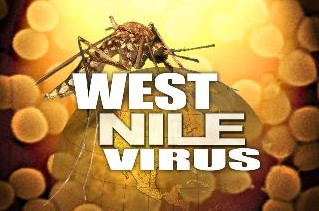Alex Constantine - September 13, 2012
 Guardian Express, September 13, 2012
Guardian Express, September 13, 2012
There are two important warnings concerning West Nile virus that is scarcely told. For one, death as a result of the disease has been recorded as unbelievably painful. Second, survivors of the disease never fully recover because West Nile attacks the nervous system in such a way that if you’re fortunate enough to survive the virus, damage to the nervous system appears to be irreparable. It is important to understand these two points in order to properly protect yourself against the disease.
The tropical disease began in birds, which passes the virus on to mosquitoes that then go on to infect human beings with a bite. Most people who contract West Nile don’t experience any symptoms at all, but about 1 in 5 suffer fever, headaches and body aches, usually lasting a week or so. A far less fortunate 1 in 150 experience high fever, tremors, convulsions, paralysis and coma. Some — especially the immune compromised and the elderly — die.
That’s what makes the major outbreaks of West Nile virus in the U.S. this summer so scary. So far, nearly 1200 cases have been reported to the Centers for Disease Control (CDC), including 41 deaths — the biggest nationwide outbreak in its brief history.
The situation is particularly bad in and around Dallas, where the virus has killed 21 people and sickened more than 586 so far this summer. The city has declared a state of emergency and, for the first time in 45 years, has begun aerial spraying of pesticide to kill the mosquitoes that are the virus’ delivery system — even in the face of residents’ heated concerns that the pesticide could be more dangerous than the disease. “I cannot have any more deaths on my conscience because we failed to take action,” Dallas Mayor Mike Rawlings told reporters recently.
Cases of West Nile Virus infections were unheard of in America until the summer of 1999 when the first instances of the disease broke out in New York City. By August 2004, the virus has spread across the continent to the West coast. Two women (an 88-year-old and a 91-year-old) were the first to die from the virus in Los Angeles County. Since 1999, more than 30,000 people in the U.S. have been reported as getting sick with West Nile virus. Already this year, as of August 2012, 43 states have reported numerous cases and deaths.
West Nile Virus encephalitis is yet another new infectious disease from an African virus that has mysteriously erupted in the U.S., seemingly out of the blue. Is this another epidemic disease like AIDS and hepatitis C that poses a threat to certain “high risk” groups? Could the outbreak of WEST NILE virus be some sort of biologic “test” (like the anthrax letter mailing attacks in September 2001) to wake people up to the dangers of bioterrorism? Are all these new “emerging infectious diseases” merely cruel and unprecedented acts of Mother Nature? Or could the “hand of man” in the form of crazy biological warfare scientists be producing these new outbreaks? Is it just a “coincidence” that all these weird bugs and illnesses have erupted in the past several decades? Or is all this just “paranoid” thinking?
New Emerging Diseases; Accident of Nature or man-made illnesses?
In the 1970s it was thought that many infectious diseases had been banished from the industrialized world. But, remarkably, over the last four decades more than 30 new “emerging infectious diseases” have appeared in various places. Some of the better-known diseases include AIDS, Legionnaire’s disease, toxic shock syndrome, Lyme disease, hepatitis C, “mad cow disease,” hanta virus, various new encephalitis and hemorrhagic viruses, Lassa fever, and Ebola virus. (New controversial diseases like chronic fatigue syndrome and Gulf War Illness affecting veterans are not included in the government’s list of “emerging diseases.”)
Health officials blame increased global travel and globalization, population growth and movements, deforestation and reforestation programs, human sexuality (in the case of HIV), and increased human contact with tropical mini-forests and other wilderness habitats that are reservoirs for insects and animals that harbor unknown infectious agents.
Nowhere in the official list of causes is the fact that for many decades millions of animals and innumerable vials of infectious material have been shipped around the world for commercial and biological warfare (b/w) purposes. The world trade in these deadly agents, coupled with gene-splicing technology, has increased the dangers of new disease outbreaks. In addition, many new viruses have been passed around between various species of animals, and some of these viruses have been adapted to human tissue. This has resulted in the production of new laboratory diseases that have potential biological warfare capabilities. The b/w implications of all these scientific “advances” have led some conspiracy-minded researchers to suspect that the hand of man might be responsible for the outbreak of one or more of these newly emerging diseases.
The new epidemic of West Nile Virus encephalitis in America
As mentioned, West Nile virus infection in humans first broke out in New York City in August 1999. The first sign of the WEST NILE epidemic occurred in early July when many birds died mysteriously. Half the crows in the New York City area died, as well as some exotic bird species housed at the Bronx zoo. The virus has an affinity for some species of birds; and the mosquito acts as a vector for the virus. Thus, the virus spreads from birds to mosquitoes, and the virus is spread to humans and other animals via mosquito bites. A few weeks after the bird kills, the first human cases of encephalitis appeared in local hospitals in the northern Queens section of the city. By September, nine of 25 infected horses with WEST NILE virus died in Long Island.
Although the virus is contagious between birds, the disease is not contagious between humans. It is estimated that only 20% of infected people will develop a mild flu-like form of the illness; but 1 in 150 people will develop a severe form of the disease with mental confusion, headache, swollen glands, high fever, severe muscle weakness, and the tell-tale symptoms of encephalitis (inflammation of the brain). Mild cases last a few days; severe cases can last several weeks. Until 2002 the virus was confined to states in the Eastern half of the country. By the summer of 2002, all but 6 of the lower 48 states reported WEST NILE virus in birds, mosquitoes, animals or humans.
Also by 2002 the CDC confirmed that a transplant patient became infected by WEST NILE virus after having received organs from a Georgia accident victim infected with the virus. There was also evidence that the virus could be transmitted by an infected mother to her infant during breast-feeding. Shockingly, it was announced that WEST NILE virus was in the nation’s blood supply. In 2005 a blood screening test was developed and approved to test for the new virus.
West Nile virus: Out of Africa? Or out of a virus laboratory?
WEST NILE virus was first discovered in 1937 in encephalitis cases in Uganda, in East Africa. African cases tended to be mild, and the virus there did not affect animal and bird populations to any significant degree. In fact, the ability of WEST NILE virus to infect and kill birds has only been noticed very recently. Could this indicate that the virus has been genetically altered or ‘weaponized’ for biological warfare purposes during the many decades that it has been available for study in virus laboratories?
Mild outbreaks of WEST NILE occurred in Israel in 1951-1954 and 1957, and also in South Africa in 1974. However, since the mid-1990s, outbreaks of increasing frequency and severity have appeared in Morocco, Tunisia, Italy, Israel, and Russia, and have been strangely accompanied with a large number of bird deaths. A Romanian epidemic in 1996 infected 90,000 people and caused 17 deaths.
Scientists have determined that the closest viral “relative” of the “New York 99 strain” of the WEST NILE virus is a strain of WEST NILE virus that circulated in Israel from 1997-2000.
Health authorities suspect the virus entered the U.S. via travelers from the Middle East or via a stray mosquito on an airplane. Other researchers claim the virus arrived with African animals or birds placed in zoos. But, in fact, the WEST NILE virus has been housed in U.S. labs for decades, and has been openly sold to researchers around the world.
It is hardly a secret that the WEST NILE virus, along with dozens of other infectious agents, was sold and shipped by the National Type Culture Collection (in Rockville, Maryland) to Iraq during the 1980s when the U.S. was on friendly terms with Saddam Hussein.
From the very beginning of the WEST NILE virus outbreak in the U.S., there were rumors that the disease outbreak was bioterrorism. However, those rumors were quickly denied by health officials. CDC spokesperson Barbara Reynolds told CNN that “the possibility of bioterrorism is at the bottom of the list for how some outbreak may have occurred. It appears Mother Nature is at work.” (CNN report, 10/11/99).
Various new theories of origin appeared in the press. For example, a Los Angeles Times editorial (9/28/02) proclaimed that “scientists think (the virus) may have arrived in the early 1980s when Asian tiger mosquitoes traveled in tire casings from Japan to Houston.” (One wonders who supplies the major media with these bizarre and undocumented stories.)
None of these theories deterred Vermont Senator Patrick Leahy from urging federal officials to determine if the introduction of WEST NILE virus is a terrorist attack. On September 12, 2002, Leahy declared: “I think we have to ask ourselves: Is it a coincidence that we’re seeing such an increase in WEST NILE virus — or is that something that’s being tested as a biological weapon against us.” Leahy is no stranger to bioterrorism, having received an anthrax-laden letter at his Washington office a year earlier.
Secret U.S. military b/w experiments on human populations
A July 24, 2000 Report (“The West Nile Virus Wake Up Call”) from the Senate Governmental Affairs Committee dismisses the idea of WEST NILE virus infection as bio warfare, although the CDC was criticized for its “tunnel vision” and its failure “to expect the unexpected.” The Committee concluded that: “The next outbreak of an infectious disease — whether naturally occurring or deliberately inflicted — may not be so forgiving.” (The 2001 anthrax attack proved to be the next “deliberately inflicted” b/w attack.)
It is surprising that the U.S. government quickly eliminated bioterrorism as a cause for the WEST NILE outbreak, particularly when the government has a long and well-documented history of b/w experimentation against unsuspecting citizens.
In the 1950s the U.S. military planned a project to cripple the Soviet economy by killing horses, cattle, and swine, with b/w weapons developed from exotic animal diseases. The animal laboratory at Plum Island, off the coast of Long Island, New York, is the Army’s repository for viruses derived from the most dangerous animal diseases in the world. According to Norman Covert, base historian and public information officer at Fort Detrick, only a handful of scientists were aware of this project. “In many cases there were only maybe five people who knew what was going on in weapons research. People in one lab didn’t know what happened in the next lab, and they didn’t ask.” Details of these Plum Island animal experiments were classified as secret until 1993. (“Plum Island’s shadowy past: Once-secret documents reveal lab’s mission was germ warfare,” Newsday, 11/21/93)
During the 1950s and 60s secret military bio warfare attacks on unsuspecting civilians took place in many parts of America. The most notorious was a six-day attack on San Francisco in which clouds of potentially harmful bacteria were sprayed over the city. Twelve people developed pneumonia due to the infectious bacteria, and one elderly man died from the attack. This attack was not revealed to the public until years later when classified documents were finally released (“Army germ fog blanketed S.F. for 6 days in ’50 test,” Los Angeles Times, 9/17/79).
In other classified experiments, the military sprayed bacteria in New York City subways, in a Washington D.C. airport, and on highways in Pennsylvania. B/w testing also took place in military bases in Virginia, In Key West (Florida), and off the coasts of Southern California and Hawaii (“Army used live bacteria in tests on U.S. civilians,” Los Angeles Times, 3/9/77).
The Army also experimented on its own West Nile soldiers. Project White coat, a code name for a series of b/w experiments that took place at Fort Detrick between 1954 and 1973, utilized about 2,300 Seventh-Day Adventist volunteers who were exposed to germs causing tularemia, malaria, anthrax, Queensland fever, Rocky Mountain spotted fever, encephalitis, and a host of other exotic diseases. The experiments were aimed at preventing, diagnosing, and treating these diseases, as well as the development of vaccines. No one died in the experiments, but critics contend that the men were essentially coerced into participating in research that, despite military assurances to the contrary, could have been used to produce b/w weapons. (“Adventists’ faith put to test; 2,300 soldiers were used in germ-warfare experiments,” The Washington Times, 10/19/98)
In preparing America for nuclear attack during the Cold War years following World War II, thousands of U.S. citizens were used as unsuspecting guinea pigs in over 4,000 secret and classified radiation experiments conducted by the Atomic Energy Commission and other agencies, such as the Department of Defense, the Department of Health, Education, and Welfare, the Public Health Service (now the CDC), the National Institutes of Health, the Veterans Administration, the CIA and NASA. (See my Internet article: “The Human Radiation Experiments”)
The full extent of the U.S. government’s experiments on unsuspecting people will probably never be known because many incriminating documents remain Top Secret or classified. Other documents are often declared as missing, destroyed, or “unavailable”, in an attempt to hide the truth from the public.
AIDS: A designer disease with a genetically-altered laboratory virus?
Some AIDS researchers believe that this Special Virus Cancer Program of the 1970s (and its covert connection to America’s b/w program) spawned the new HIV virus that was subsequently seeded into the U.S. homosexual community via the government-sponsored experimental hepatitis B vaccine program (1978-1981). These experiments in Manhattan , Los Angeles, and San Francisco, utilized only highly promiscuous, healthy white gay and bisexual men as guinea pigs. Shortly after this experiment began, the first cases of “gay-related immune deficiency disease” (later known as AIDS) erupted in New York City in 1979. (See my article “The man-made origin of AIDS”.) The idea of AIDS as a man-made virus that was deliberately seeded via vaccine programs into the American gay and African black population in the late 1970s is considered by most scientists to be a joke. Scientists pooh-pooh the idea of a “man-made” virus, even though the laboratory transfer of viruses from one species to another always results in a “man-made virus”.
Killer Germs for Sale
Further complicating bioterrorism is the sale of deadly microbes to anyone and any country with the cash to buy them. From 1985-1988, when the U.S. was still friendly with Saddam Hussein, his Education Ministry purchased 70 shipments of anthrax, West Nile virus, and other disease-causing organisms from the American Type Culture Collection, in Maryland. At that time, such shipments were entirely legal and received quick approval by the U.S. Commerce Department. (“Germ library’s inventory is making detractors queasy,” Los Angeles Times, March 16, 1998.) Even after Hussein gassed the Kurds in 1988, and even after the Gulf War, U.S. officials continued to supply Iraq with biochemical warfare ingredients (“U.S. was a key supplier to Saddam,” Seattle Post Intelligencer, Sept 24, 2002). The CDC also sent WEST NILE virus and numerous other biological agents to Iraq during the years 1984 and 1993.
The Riegle Report (May 25, 1994) further details biological and biochemical shipments from the U.S. to Iraqi government agencies. It was later learned that these microorganisms exported by the U.S. were identical to those the UN inspectors found and recovered from the Iraqi b/w program.
Was West Nile virus deliberately seeded into the environment?
Could the new outbreaks of WEST NILE virus be a result of decades of animal experimentation and manipulation of the African virus in various laboratories worldwide? Surely over the past 60 years new strains of WEST NILE virus have been developed and “weaponized” by genetic and/or b/w engineers. Once a virus like WEST NILE is “introduced” into the environment it can subsequently spread rapidly on its own. Already the WEST NILE virus causes disease in humans, and animals and birds, unlike that seen in Africa back in the 1930s. In 2002, there were various media reports claiming that some WEST NILE patients were developing signs and symptoms of polio, even though that disease is caused by a different virus. Could these never-before seen manifestations of WEST NILE virus be an indication that the virus has been altered in a laboratory? Could this more deadly form of WEST NILE virus reflect manipulation, not by Mother Nature, but by the hand of man?
Besides acting as a wakeup call, what would be the advantage of introducing WEST NILE virus into the American environment? For a foreign terrorist, WEST NILE virus would be a poor choice of bioweapon. As a killer of old and sick people, it would not be a terribly effective b/w weapon. However, if the virus was introduced domestically as a “test” (like anthrax), the killing off of old and sick people would certainly aid the fiscal problems of Social Security and Medicare.
How many more wake up calls with bioterrorism will be required before health officials stop looking in rain forests and African animals for the origin of these new epidemic diseases —and begin to look at the world trade in deadly infectious agents, and the insanities of bio warfare research.
Bio warfare agents are designed solely to kill large numbers of civilians. And any country that is willing to employ and deploy these agents should be fully aware that — What Goes around Comes Around.
http://guardianlv.com/2012/08/west-nile-virus-question-that-have-never-been-answered/









